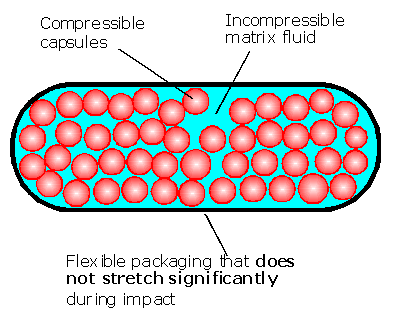
Shock Absorbing Liquid (SALi)
SALi in a nutshell

SALi based cushions are used for protecting people and property from violent impacts, vibrations and shock waves.
They consist of lots of small, compressible elastic capsules blended with an “incompressible” matrix fluid, with the mixture being retained in a strong package, which does not stretch significantly during an impact.
Figure 1. The essential features of a SALi based cushion.
The Sassy Hats Project is a NESTA supported feasibility study which enables us to work with a professional clothing designer to create prototypes for a new generation of soft, stylish protective headwear. We envisage these hats being used for medium risk activities such as winter hill walking and energetic child play, where wearing a conventional hard hat would be seen as eccentric.
Protecting young brains
The occasional broken limb is a price worth paying for the awareness of risk learned in adventure child play. But head injuries are different; they can result in lifelong brain injury.
What are core characteristics?
Core characteristics are sets of data about the energy dissipation provided by a tiny cube shaped sample (unit ceell) of SALi material.
Why engineers need them
Testing prototype impact absorbers is an expensive business. So, to keep costs down, engineers carry out computer simulations first.
These computer simulations treat any shape of SALi based impact absorber as being made up of these smal cubes. (Rather like building a Leggo model, but using simple cube shaped Leggo blocsonly.) During an umpact the size of each cube is reduced.
So, before computer simulations can begin, researchers need to obtain experimental core characteristic data relating to different stresses, strains and strain rates.
This is quite a research challenge because each of the many different formulations of SALi has its own set of core characteristics.

Figure 1. If engineers have core characteristic data, they can feed this into computer models that predict the impact absorbing performance of different shapes and sizes of SALi filled bags.
Core characteristics will provide information about:
(i) Elastic energy absorption.
(Which is useful because it allows the impact absorber to recover its shape after an impact.)
and,
(ii) Viscous damping energy absorption.
(Which is important because it prevents secondary damage caused by the impact absorber recovering too quickly.)
Battery charging car suspension Patent application GB0915807.2
Aim: To design a car suspension unit that offers "outstanding performance" and has excellent green energy credentials.
The suspension unit is based on Shock Absorbing Liquid (SALi) Technology, with simmple power generators being used to convert vibration energy into electricity.
[The claim that SALi based vehicle suspension units offer "outstanding performance" was oriignally made by independent SALi researchers in China.
H. d. Teng, Q. Chen, Study on vibration isolation properties of solid and liquid mixture, Journal of Sound and Vibration, 2009 doi.10.1016/j.jsv.2009.04.036.]
© 2026 Guardian Angle PC Support
